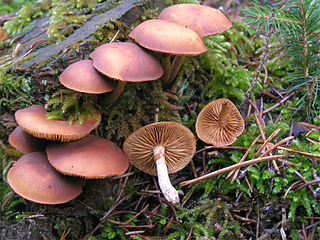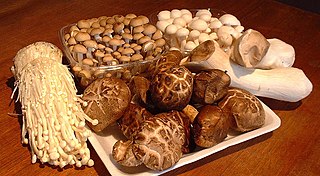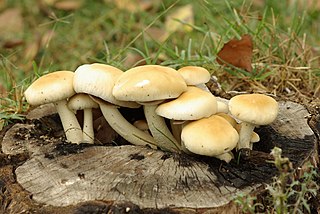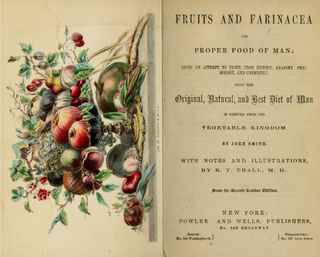
Galerina is a genus of small brown-spore saprobic fungi, with over 300 species found throughout the world from the far north to remote Macquarie Island in the Southern Ocean. The genus is most noted for some extremely poisonous species which are occasionally confused with hallucinogenic species of Psilocybe. Species are typically small and hygrophanous, with a slender and brittle stem. They are often found growing on wood, and when on the ground have a preference for mossy habitats.

The adjective hygrophanous refers to the color change of mushroom tissue as it loses or absorbs water, which causes the pileipellis to become more transparent when wet and opaque when dry.

A germ pore is a small pore in the outer wall of a fungal spore through which the germ tube exits upon germination. It can be apical or eccentric in its location, and, on light microscopy, may be visualized as a lighter coloured area on the cell wall.

Shimeji is a group of edible mushrooms native to East Asia, but also found in northern Europe. Hon-shimeji is a mycorrhizal fungus and difficult to cultivate. Other species are saprotrophs, and buna-shimeji is now widely cultivated. Shimeji is rich in umami-tasting compounds such as guanylic acid, glutamic acid, and aspartic acid.

Agrocybe is a genus of mushrooms in the family Strophariaceae. The genus has a widespread distribution, and contains about 100 species.

Charles Horton Peck was an American mycologist of the 19th and early 20th centuries. He was the New York State Botanist from 1867 to 1915, a period in which he described over 2,700 species of North American fungi.

Agrocybe pediades is a typically lawn and other types of grassland mushroom, but can also grow on mulch containing horse manure. It was first described as Agaricus pediades by Swedish mycologist Elias Magnus Fries in 1821, and moved to its current genus Agrocybe by Victor Fayod in 1889. A synonym for this mushroom is Agrocybe semiorbicularis, though some guides list these separately. Technically it is edible, but it could be confused with poisonous species, including one of the genus Hebeloma.
Psilocybe farinacea is a species of mushroom in the family Hymenogastraceae.

Agrocybe praecox is a species of brown-spored mushroom which appears early in the year in woods, gardens and fields. According to modern taxonomic analysis, it is just one of a cluster of closely similar species which are often referred to as the Agrocybe praecox complex. It is found in Europe, North Africa and North America.

Agrocybe putaminum, commonly known as the mulch fieldcap, is a species of agaric fungus in the family Strophariaceae in the Agrocybe sororia complex. Described as new to science in 1913, it is found in Asia, Australia, Europe, and western North America, where it grows in parks, gardens, and roadsides in woodchip mulch. Fruitbodies of the fungus have a dull brownish-orange cap with a matte texture, a grooved stipe, and a bitter, mealy taste.

Cyclocybe aegerita, also called Agrocybe cylindracea, Agrocybe aegerita or Pholiota aegerita, is a mushroom in the genus Cyclocybe which is commonly known as the poplar mushroom, or velvet pioppini. In Japan, it is called Yanagi-matsutake (柳松茸).
Unspecific peroxygenase (EC 1.11.2.1, aromatic peroxygenase, mushroom peroxygenase, haloperoxidase-peroxygenase, Agrocybe aegerita peroxidase) is an enzyme with systematic name substrate:hydrogen peroxide oxidoreductase (RH-hydroxylating or -epoxidising). This enzyme catalyses the following chemical reaction

Amanita ananiceps is a species of agaric fungus in the family Amanitaceae native to Australia.
Conocybe moseri is a mushroom species in the family Bolbitiaceae. It was described as new to science in 1980 by mycologist Roy Watling, from collections made in France. The specific epithet moseri honours Austrian mycologist Meinhard Moser. The fungus has been reported from the United Kingdom, growing in grassy areas, fields, and edges of woods. In 1995, it was recorded from Switzerland, from Ukraine in 2007, and from Russia in 2007. It was reported from India in 2015, where it was found growing on cattle dung.

Agrocybe rivulosa is a species of mushroom in the genus Agrocybe. The first recorded sighting of the mushroom was in 2003. The species was first found in Britain in the year 2004. It is a relatively large mushroom, with a stem of 5 to 10 centimeters, and a cap which reaches 4 to 10 centimeters across. The colour of the cap ranges from yellow to pale orange-brown. It has been eaten, and is reasonably tasty with no obvious toxicity.

Agrocybe retigera is a species of mushroom in the genus Agrocybe. The first known sighting of the species was in the early 1950s. It was first described by author Speggazini Singer in 1950. The mushroom has since been found in common areas, especially grassy ones, such as gardens, meadows and parks. Agrocybe retigera is most commonly found in tropical and sub-tropical areas around the globe. The size of the cap is usually between 17 and 44 millimetres, and it is generally pale in colour. The colour of the mushroom itself ranges from cream to pale-brown.
Agrocybe smithii is a species of mushroom in the genus Agrocybe. This species is a pileate-stipitate fungi, and has a medium size of fruitbodies. The cap is convex to plane-convex; yellowish brown. The hymenium is gilled with adnexed gills, initially whitish, but later dark brown. Odour mealy and taste bitter. The stipe is central, cylindrical and lacks a partial veil; usually has mycelial cords in the stipe base. Its spores are short, broadly ellipsoid to ovoid, smooth with a germ pore. Its pellis has large, rather inflated cheilocystidia which are more or less flask-shaped. Often found growing on wood chips.

Agrocybe sororia is a species of Basidiomycota mushroom in the genus Agrocybe. The cap is convex to plane, tawny fading to pale yellow-buff; the pileus sometimes is cracked, or wrinkled. The gills have an adnate attachment to the stipe. The spore print is cinnamon-brown. The stem is cylindrical, equal, concolor with the cap and lacks a ring; usually with white cords in the stem base. It is found in wood mulch. Odour and taste mealy. This mushroom distributes in eastern North America.

Fruits and Farinacea: The Proper Food of Man, Being an Attempt to Prove, from History, Anatomy, Physiology, and Chemistry, that the Original, Natural, and Best Diet of Man is Derived from the Vegetable Kingdom is an 1845 book advocating vegetarianism by John Smith.

Cyclocybe parasitica, also known as tawaka in te reo or poplar mushroom, is a species of gilled mushroom in the genus Cyclocybe found mostly in New Zealand and Australia. It grows on native and introduced trees where it can cause heart rot, and does not seem to be associated with conifers.















